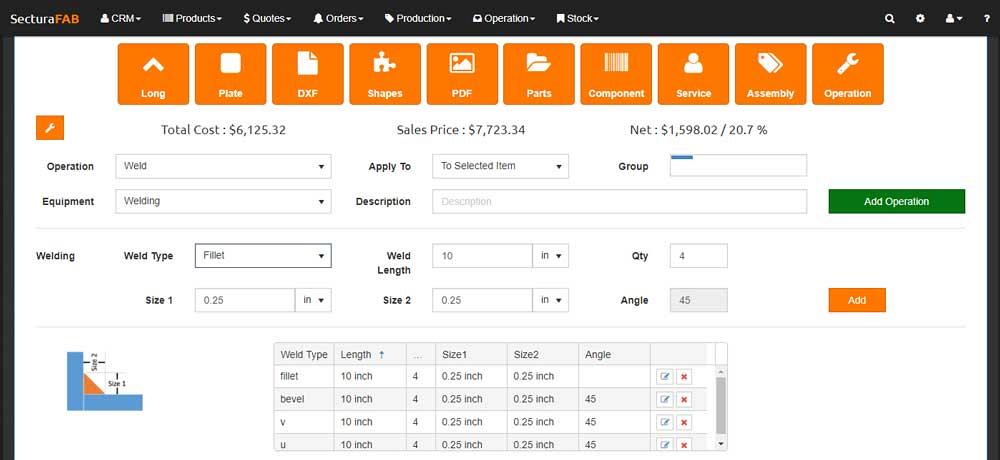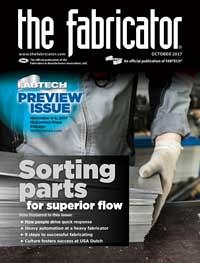Chief Operating Officer
- FMA
- The Fabricator
- FABTECH
- Canadian Metalworking
Categories
- Additive Manufacturing
- Aluminum Welding
- Arc Welding
- Assembly and Joining
- Automation and Robotics
- Bending and Forming
- Consumables
- Cutting and Weld Prep
- Electric Vehicles
- En Español
- Finishing
- Hydroforming
- Laser Cutting
- Laser Welding
- Machining
- Manufacturing Software
- Materials Handling
- Metals/Materials
- Oxyfuel Cutting
- Plasma Cutting
- Power Tools
- Punching and Other Holemaking
- Roll Forming
- Safety
- Sawing
- Shearing
- Shop Management
- Testing and Measuring
- Tube and Pipe Fabrication
- Tube and Pipe Production
- Waterjet Cutting
Industry Directory
Webcasts
Podcasts
FAB 40
Advertise
Subscribe
Account Login
Search
It's time to accelerate the quoting process
That means ditching the old spreadsheet
- By Brad Stropes, Patrick Medlin, and Robert Farrell Jr.
- October 17, 2017
- Article
- Shop Management
Congratulations! The quote you started a few days ago for that big job is finally finished. You collected all of the information, plugged the numbers into Microsoft Excel, looked it over one last time, and fired off what was sure to be a winning bid. Now you can kick back and relax knowing that your shop will be busy for weeks and your company’s bottom line is about to get a much-needed boost.
Unfortunately, you’re about to get hit with a cold dose of reality. Your bid was too late. Another fabricator has already been awarded the job.
Tardiness is not the only thing that costs fabricators. Some crank out numerous quotes a day, and they still run into problems because of lack of standardization of those quotes. When the sales force is free to generate quotes at its own discretion, not following a common template, quotes can vary wildly from one person to the next. The results can be an unnecessarily high bid, money left on the table, or a money-losing proposition—the worst of all scenarios.
No matter if you’re a very small job shop or a larger metal service center, it’s time to take a closer look at your quoting tool. Electronic spreadsheets have been around since the late 1970s and were once the standard for quoting and other business applications. But their time has passed. Times have changed.
Comparing Excel to advanced quoting software programs is like comparing a land-line telephone to a smartphone. Maybe it’s time to give Excel the boot and begin using something more automated and advanced (see Figure 1).
The Way We Were
In the past an inherent knowledge was needed to create quotes. See if this rings a bell: Responding to an RFQ, your senior salesperson grabs a part and takes some quick measurements; looks up the last known material rates; estimates how long cutting may take; and factors in cleaning, painting, and other secondary operations. Using years of experience that person instinctively knows what the market will bear and slaps together a hopeful quote. (Hopeful is the operative word.)
For fabricators that are using advanced quoting tools, this certainly sounds like an archaic and ineffective approach—and it is. But for too many fabricators and job shops, this guesstimate-driven approach remains the status quo. In today’s fast-paced, quick-turnaround world, the fastest quote often wins the job. Consequently, it’s little wonder that fabricators who are not embracing more efficient and automated quoting tools are feeling the effects.
What’s the answer? What can job shops and fab shops on limited budgets do to improve quoting success? Many have turned to material resources planning (MRP) systems in an attempt to automate the process. However, most of today’s commercial MRP and job quoting systems remain heavily dependent on users to provide very basic information, such as perimeter length, surface area, and number of holes. To get that information, the estimator is expected to load part geometry into a CAD/CAM system and wait for potential cutting paths and nesting strategies to be generated. Those results are then manually entered back into the quoting software. Such a process is slow, hardly automated, and not very efficient.
Real-time Quotes
What if you could capture the expertise of your lead estimator in an electronic template format and leverage that experience with the most updated production, material, and resource information? This would not only speed the quoting process measurably, but would create the most accurate quotes while providing a standardized process throughout the company. The development of integrated web-based quoting means the end of late and wildly inaccurate quotes.
This new approach to quoting is a smart process that uses the information contained in today’s intelligent CAD models. This model-driven approach allows you to know exactly how the job can be nested to maximize material use. This in turn determines exactly how much of a given material is needed to complete the job. At the same time the integrated process examines inventory to determine if stock is available to complete the job. Up-to-the-minute material pricing can be accessed to calculate costs for any additional material that will need to be purchased. Furthermore, sophisticated quoting software even allows you to combine work orders to fully use material and production run-time and costs.

Figure 1
Quoting software that allows for dynamic changes and provides complete pictures of a job quote can be useful in delivering quick and accurate quotes. In turn, a job shop can be more competitive in the bidding process and more profitable when it comes to tackling the jobs.
In this digital world, everything is accelerated, including expectations. From receiving competitive bids to finished-part deliveries, customers demand fast turnaround, and in most instances, they’re getting it. Intelligent web-based quoting shaves hours off of the quoting process.
As an example of how this works, let’s focus on nesting. Today’s advanced software contains multiple advanced nesting algorithms built right into the quoting platform, delivering material checks, sheet optimization reports, and accurate costs with the click of a button. The software also uses your machines’ technology tables for the most accurate run-times. Once a cost has been established, the program integrates directly into your CAD/CAM nesting system, allowing parts and sheets to travel back and forth through both programs. This connectivity allows you to quickly obtain part completion updates and true sheet utilization while tracking individual parts.
Ensuring Profitability
Profits are made or lost in the early upstream quoting stage. Those shops using Excel or other slow, inaccurate, manually intensive quoting processes are never really certain if a job is going to be profitable. These companies walk a fine line, padding the quote to cover the unknown, yet still hoping to remain competitive.
In a true lean manufacturing environment, that type of thinking won’t work. Too much time and effort are wasted putting together quotes that don’t reflect real-world times and costs. Again, that’s where advanced quoting software can make a difference. It provides you with flexibility and a distinct advantage over the competition. Specifically, it allows you to put together accurate and profitable quotes in the most efficient manner possible.
If your lean shop is using this type of quoting prowess, it is in an excellent position. It already has a handle on available capacity and knows if costs for the month are covered. This type of knowledge allows you to accommodate and exploit new business opportunities.
Think about it: If you have capacity and the costs are covered, then you can take jobs for less than what is likely to be the competitors’ going rates and still make more money. Let’s call this opportunity capacity, where you can generate quotes and regenerate quotes very quickly while playing the what-if scenario. Profitability on every job is important, but what is most important is overall profitability at the end of each month.
What Does Intelligent Quoting Do for a Fabricator?
Integrated web-based quoting offers you a number of advantages over the archaic world of spreadsheets:
- Quoting becomes simpler. Software dashboards contain fields that, once populated, launch behind-the-scene calculations involving, for example, rates, material costs, machine run-time, secondary operations needed, and associated costs. This eliminates the need to have a seasoned fabricating veteran create quotes.
- Information is more accessible. Web-based quoting is accessible by virtually anyone at any place. From laptops to tablets and cellphones, quotes can be generated on any device.
- Quotes are created quickly and accurately. Because multiple manual touch points are eliminated, paperless, web-based quoting greatly simplifies and speeds the process. In a world where the fastest quote often wins, bids that have traditionally taken an hour or more to produce can be generated in five minutes or less.
- Quotes are more consistent. Your custom dashboard provides a common template for all who create quotes. Tapping into actual costs uniformly ensures that all quotes, regardless of the experience of the salesman, are consistent and profitable (see Figure 2).
- The quoting system is more easily managed. As a web-based system, software updates are performed at a single location and pushed out to software users. This cloud-based quoting approach is available as an affordable subscription service.
Dictating Profitability
Today’s intelligent web-/cloud-based quoting systems replace guesswork and inaccurate data with the most accurate variables. Leveraging up-to-the-minute material costs, labor rates, machine run-time, finishing operations, and related information helps to create winning quotes that can be generated in a matter of minutes. Additionally, the flexibility of such systems allows you to customize quoting per your unique standards or requirements monitored and adjusted by management.
Some tried-and-true methods are worth hanging on to. But fabricators who continue to rely on manual or Excel-based quoting methods are quickly losing ground to those who are opting for automated quoting tools. Replacing dated information or best guesses with known variables is a competitive advantage for those with the ability to quickly pull such details together.
Look at it this way: Every manufacturing operation costs money. Capturing expenses allows you to generate actual numbers. Once these known costs are determined, you can then mark up services. Once run-times, number of operators needed, and processing time are known, these other costs can be added. But doing this accurately requires applying real part geometry against materials. Making quotes based on these real-world details can save hundreds of labor-hours each year.
Using known pricing, run-time, and other production variables, you can use web-based quoting to dictate profitability—not hope for it.

Figure 2
Often job shop estimators have varying levels of experience. As a result, when faced with an unfamiliar fabricating or welding process, such as beveling, inexperienced estimators might deliver a quote that is quite different than a more experienced peer’s quote. Advanced quoting software helps to capture accurate costs and keep quotes consistent, even when an inexperienced estimator is involved.
About the Authors
Patrick Medlin
President
336-393-0030

Robert Farrell Jr.
Owner
513-284-2618
subscribe now

The Fabricator is North America's leading magazine for the metal forming and fabricating industry. The magazine delivers the news, technical articles, and case histories that enable fabricators to do their jobs more efficiently. The Fabricator has served the industry since 1970.
start your free subscription- Stay connected from anywhere

Easily access valuable industry resources now with full access to the digital edition of The Fabricator.

Easily access valuable industry resources now with full access to the digital edition of The Welder.

Easily access valuable industry resources now with full access to the digital edition of The Tube and Pipe Journal.
- Podcasting
- Podcast:
- The Fabricator Podcast
- Published:
- 04/16/2024
- Running Time:
- 63:29
In this episode of The Fabricator Podcast, Caleb Chamberlain, co-founder and CEO of OSH Cut, discusses his company’s...
- Industry Events
16th Annual Safety Conference
- April 30 - May 1, 2024
- Elgin,
Pipe and Tube Conference
- May 21 - 22, 2024
- Omaha, NE
World-Class Roll Forming Workshop
- June 5 - 6, 2024
- Louisville, KY
Advanced Laser Application Workshop
- June 25 - 27, 2024
- Novi, MI
































